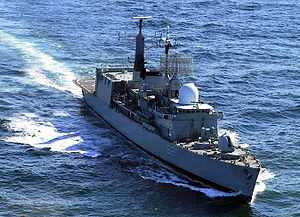ARA Hércules (B-52)
 ARA Hércules after her conversion | |
| Career (Argentina) | |
|---|---|
| Namesake: | After a frigate commanded by Admiral Guillermo Brown in 1814 |
| Ordered: | 18 May 1970 |
| Builder: | Vickers Shipbuilding and Engineering |
| Laid down: | 16 June 1971 |
| Launched: | 24 October 1972 |
| Acquired: | 10 May 1976 |
| Commissioned: | 12 July 1976 |
| Reclassified: | 1999 |
| Homeport: | Puerto Belgrano Naval Base |
| Fate: | Active |
| General characteristics | |
| Class and type: | Type 42 destroyer |
| Displacement: | 4,100 tons (4,170 t) |
| Length: | 125 m (410 ft) |
| Beam: | 14.6 m (48 ft) |
| Draught: | 5.2 m (17 ft) |
| Propulsion: | COGAG - 2 × RM-1A gas turbines (8,200 shp (6,100 kW)); 2 × TM-3B gas turbines (54,400 shp (40,600 kW)) 2 shafts |
| Speed: | 28 knots (52 km/h) |
| Complement: | 270 as Destroyer 166 (+238 troops) as Multipurpose Transport |
| Armament: | As Destroyer
As Multipurpose Transport
|
| Aircraft carried: | As Destroyer
As Multipurpose Transport |
ARA Hércules is a Type 42 destroyer of the Argentine Navy or Armada de la República Argentina. She was transformed into a multi-purpose transport ship with Pennant Number B-52 and commissioned to the amphibious force in 1999.
History
The ship was ordered on May 18, 1970 and completed on May 10, 1976 at the Vickers Shipbuilding yard in Barrow-in-Furness, United Kingdom. During construction, an explosion on HMS Sheffield (D80) caused damage in the hull.[1] The hull of the Hércules replaced a section of the ship, as both were identical in build.[2] She was delivered to Argentina and entered service on September 19, 1977. As built, she was identical to the initial Type 42 units being commissioned by the Royal Navy. The Argentine Navy upgraded the warship by enhancing her offensive capabilities with MM-38 Exocet missiles. The original boat decks by the funnel were modified in order to mount the launchers.[3][4]
In 1982, along with her newly built sister ship, ARA Santisima Trinidad , she was part of the escort of the aircraft carrier ARA Veinticinco de Mayo during the Falklands War.[5]
The ship had a major conversion at astilleros ASMAR in Talcahuano, Chile in 2000 to allow the embarkment of a complement of 238 marine infantry troops, the flight deck and hangar were also enlarged to allow her to operate two Sea King helicopters. Each helicopter can also carry two AM-39 Exocet anti-ship missiles.[6]
References
- ↑ Commons debate - 4 May 1971
- ↑ A Rip in Time for Sheffield Navy News, April 2007
- ↑ "Differing little from their British sisters, they did however mount Exocet." Haws, Duncan:Elders & Fyffes and Geest. TCL Publications, 1997. Item notes: v.32 1997. ISBN 0-946378-31-2
- ↑ Tecnología militar, Volume 26. Grupo Editorial Mönch, 2004, page 103 (Spanish)
- ↑ Smith, Gordon: Battle Atlas of the Falklands War 1982 by Land, Sea and Air. Lulu.com, 2006. Page 56. ISBN 1-84753-950-5
- ↑ Transporte Multiproposito B52 ARA Hercules official site (Spanish)
| ||||||||||||||||||
| |||||||||||||||||||||||||||||||||||||||||
